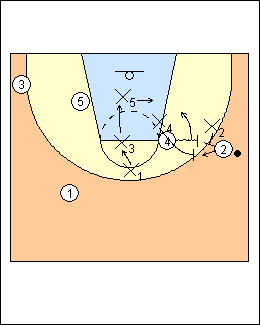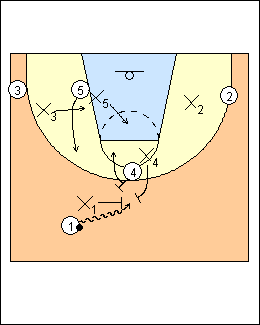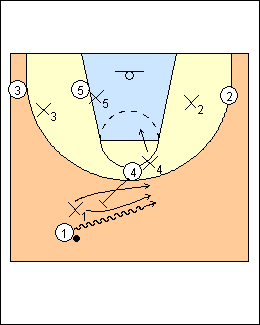Defending on-ball screens
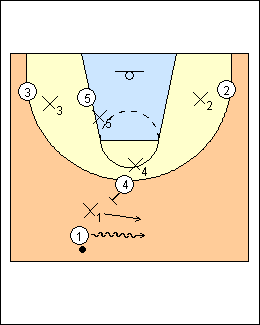 | 1 Coverage options - Pushing out - Weak - Gap - Switch - Drop Ken Shields - pick and roll is now very important because of the 3-point shot. Have at least 2-3 ways to defend and know how you will start the game. It takes five players to defend ballscreens, the other players take two steps off their men and are ready to rotate to open men. Matt Woodley - you are a show team or a drop team. Two people on the ball above the screen is becoming more difficult. A drop team protects the basket, keeps the ball and the roller in front of them. They are an ice team on side pick and rolls, and a weak, drop-and-under team in the middle of the floor. This keeps them out of rotations, the big is in good position to corral the ball, no free rolls to the basket. You should be able to guard all ballscreens 2-on-2. Pushing Out The on-ball defender (xdribbler) tries to force the dribbler out and away from the screen, with no defensive rotation. Alvin Gentry - hold your ground when guarding the ballhandler, don't allow him to locate the ball below the hashmark. Be physical guarding the screener, hold him up, don't let him run in a straight line to set a ballscreen. This combination moves the ballscreen further away from the basket. Pitt - it's sometimes hard to use a head-on ballscreen, X1 should be able to angle 1 away from the screen.  |
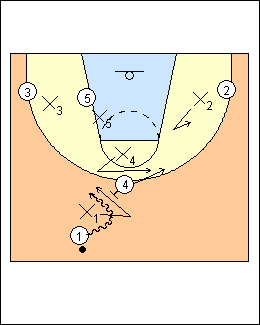 | Weak The on-ball defender forces the ballhandler to use the weak hand, but cannot allow a straight-line drive. The screen defender helps against a drive, then recovers. Herb Brown - send the dribbler towards his weak hand or away from the screen, X4 zones up in centre field. Matt Woodley Ballscreens - X1 guards the ball with his nose on 1's right shoulder, forcing him left, that is going to be their weak coverage no matter which way 4 comes up to screen. Once X1 hears X4 yell "weak" he gets into the ball and forces left. It is harder to pass left-handed. Messina Ballscreens - on a middle ballscreen, X1 gives the ballhandler only one option, shades to his weak hand. A flat ballscreen is the most dangerous, very important to give only one option. Jeff Van Gundy - against a straight-on ballscreen, always play weak with no confusion, xscreener plays soft between the ball and the basket, drops to the dots, or can show. Jamie Dixon - go weak on a head-on ballscreen, X1 forces 1 to his weak hand, X4 hedges, X1 goes through (over the screen, under X4, see Show high-low). |
 | Show and Recover The ballhandler is a dangerous outside shooter, in scoring range, and the screener is not a threat. The on-ball defender gets "skinny" and goes over both the screener and xscreener. Here attacker 4 sets a screen for ballhandler 1. The defender of the screener, X4, calls "left" and steps out on the screener's top hip to fake a switch or trap, forcing 1 to pick up the dribble or change direction away from the basket, and giving on-ball defender X1 room to go over the screen. X4 then drops back quickly to stop a pass to the screener. X4 stays attached, keeping one hand on 4 as a "feeler". The hedger doesn't jump out too early or will get split by the dribbler. Mike MacKay - by sliding over the screen, xdribbler is vulnerable to the dribbler faking to use the screen and then driving baseline, so xdribbler "muscles" the pick, turning sideways, forcing the dribbler to use the screen, and using his forearms to bulldoze through the screen, with one forearm on the hip of the dribbler and the other on the hip of the screener. By showing his chest, xscreener takes away the passer's vision, making it difficult to pass to the screener. Morgan Wootten - xscreener steps out into the path of the dribbler and hedges to delay and contain the ball, allowing xdribbler time to fight over the screen and get back in front of the dribbler. Jeff Van Gundy - with regular "show", X4 steps out but stays attached to the screener, often screening X1. Mike Fratello - show and over - as soon as he hears "left", xdribbler jumps on the bottom side to take the ball to the screen, and gets up into the ball, closing down the space. Roy Williams - they defend ballscreens three ways, in each case xscreener shows high. Show high and go over is the regular way, X4 shows with his right hand touching 4 (in case the screener slips to the basket), then gets back. They will also trap, or show and go under (see below). Ken Shields - xscreener must show on a ballscreen inside 3-point range, a weakside big covers the screener if he slips to the basket. Larry Brown - defending an elbow (Horns) ballscreen, no hedge is needed, xdribbler goes over the screen.  |
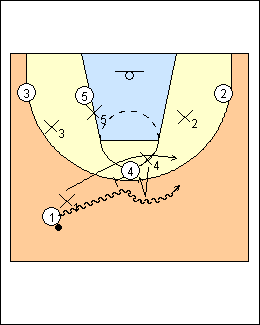 | Show and Under Mike Fratello - show and under - the xscreener shows in the dribbler's path, xdribbler goes under the xscreener and the screener. Tom Izzo - up and under - xscreener steps straight up but maintains contact, xdribbler goes under the screen (the dribbler is a good shooter but not a handler, he won't turn the corner). Mike Mackay - under/hedge - some teams are starting to use this, xdribbler goes under the screen while xscreener shows a high hedge, forcing the dribbler high and giving xdribbler time to recover. The best counter is a re-screen, catching both defenders on the other side, or the screener sprints to space. Alvin Gentry - anytime a ballscreen is set clearly above the NBA 3-point line, xdribbler goes under the screen. When defending ballscreens against great players, choose what to give up, e.g., when defending John Stockton go under a ballscreen, give up a jump shot rather than deal with Stockton's penetration. Roy Williams - if the dribbler is not very good at pulling up and shooting, they allow X1 to go behind but X4 still shows high. Scott Clark - 12 - is very good vs. pick and pop, the show man should recover to the passing lane. Bob Hurley - we don't go under ballscreens, screw the scouting report that says he's a non-shooter, we're St. Anthony, we don't go under ballscreens here. |
 | Gap The ballhandler has limited shooting range and/or is a great dribble penetrator. The xdribbler calls "gap" and goes through the screen, i.e., between the screener and xscreener. X4 forces ballhandler 1 laterally across the court, leaves room for X1 to go through the screen, pushes X1 through on the hip, then recovers to the screener. Woodley - X1 has to force 1 into the screen, and can slide or spin under the screen. X4 matches 1's numbers (chest to chest). Messina - outside scoring range X1 goes under the screen and over X4. They want to deny as much as possible, go under on the first pick and roll, force a re-screen, then the offensive angles change. See 4 on 4 ballscreens. |
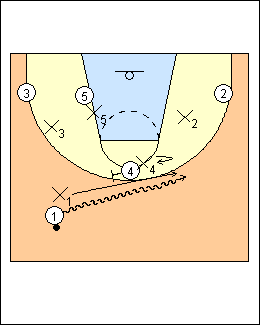 | Feather (Soft or Flat Hedge) Mike MacKay - over/hedge - the xdribbler goes over the screen while xscreener stays in the small of the screener's back and shows laterally, not allowing the dribbler to turn the corner. Again, this is vulnerable to X1 faking to use the screen and driving baseline. Tom Izzo - feather - xscreener soft hedges sideways, xdribbler goes over the screen, xscreener pulls him through then gets back to the screener (worried about the dribbler turning the corner, also about pick and pop). Danny Manning - defending ballscreens, they will hard hedge, flat hedge, squeeze and go under (bump the screener up), or push it down (blue). Jim Boone - "level show" on a middle ballscreen, X1 bodies up, in and over (1 can't reject, deter a shake pass to 3), X4 stays level with the screen, squared, until the ball is passed, hands down to prevent a split. Xavi Pascual (FIBA Assist 37) - xdribbler aggressively goes above the screen, xscreener goes out in line with the screen, preventing the dribbler from splitting the screen, then recovers when xdribbler is ready to recover on his man.  |
 | Squeeze (Jam) The ballhandler is not an outside threat. The xscreener plays tight (jam or hug the screener), forcing the screener out into the ballhandler's path, and xdribbler goes under both players, protecting against a drive. Used to defend the pick and pop when the screener is a dangerous outside shooter; also defends the roll by being between the screener and the basket. Often used when the ballhandler is outside shooting range. The xscreener puts up his hand to disrupt any shot. Bob Huggins - if xscreener can re-route the screen above the arc, then squeeze or gap; if the screen is inside the arc, trap or show and go over. X5 absorbs the roll on a trap. Kyle Gilreath - typically it is easiest to jam a screen when the big is stationary and not sprinting into the pick. Mike MacKay - the dribbler is not a shooter but the screener is, xscreener pushes up tight to the screen with a hand up, giving xdribbler lots of room, and making it difficult for the screener to roll or sprint to space. Tom Izzo - jam - 1 is not a good shooter, 4 is a great player. Alvin Gentry - squeeze and under is a great way to defend a middle ballscreen. You have to squeeze anytime xdribbler goes under, otherwise the screener can move down closer to the basket. Ken Shields - squeeze and go under a high ballscreen outside 3-point range, xscreener bodies his man up and out to extend the screen, xdribbler goes under to cut off dribble penetration. Good against a pick and pop shooter. coachesclipboard.ca - 2 under - the screener is an excellent shooter (pick and pop), the dribbler is not a deep-range shooter or great penetrator. The xcutter must be quick to get under, and xscreener must be tight to the screen, not in xdribbler's path. Larry Brown - when xdribbler goes under the ballscreen, the screener automatically turns for a re-screen, automatically trap the re-screen. goxavier.com - switch on any re-ballscreen, xscreener does not have a good angle to hard hedge (xdribbler goes under the screen to switch).  |
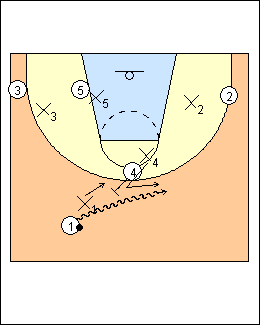 | Switch X1 goes under the screen, X4 can show or flat hedge. Woodley - he believes in switching groups, players that all switch together (e.g. players a-b-c), that keeps them out of rotations. X1 and X4 switch to touch, under the screen. Oakland - X4 connects with 4 so he can't get split, steps out and takes the ball a step above the screen, don't let 3 come off and take a jump shot. X4 has his belly to the far baseline, it's not a hard shock trying to force 1 back. The pack-line defence builds a wall. X1 and X4 would switch right back on a re-screen. Steve Wojciechowski - flat switch on a guard-to-guard ballscreen (not a jump switch). Smart - don't just softly switch it, a good team will figure it out. Still get up and bully the ball, X1 is going to go under, X5 is going to hit it as if he's showing, then backs off. O'Neill - switch on a small-small or big-big ballscreen, or the last 8 seconds regardless of size. X4 is at the level of the screen, hand on, jumps the dribbler hard, X1 goes behind the screener to pick him up. Messina - they jump switch in scoring range (switch vertically), X1 goes under the screen. Severns - usually an aggressive jump switch to make the ballhandler pick up the dribble or go away from the basket, almost always done in a low-clock situation. Thad Matta - switch screens 1-4. Del Harris - the best defence against ballscreens is to switch the switchable ones. You will normally want to have a trap option, and may want an aggressive option for your athletic screen defenders and a more containing one for slower big players. The easy way out is to have only one or two ways. Hoop Tactics - switch on ballscreens above the foul line extended, trap (or trap early) below it. Mike Fratello - xdribbler has to get under the screen, the switch can be parallel or xscreener can jump out to send the ball back where it came from, which is a little harder. Mike MacKay - going under prevents the screener from rolling to the basket and running to space, but you get caught behind him and are easily posted; going over gets a front position and can force a more difficult pass, but you can get sealed on the roll. Kevin O'Neill - switch on a small-small or big-big ballscreen, or the last 8 seconds regardless of size. X4 is at the level of the screen, hand on, jumps the dribbler hard, X1 goes behind the screener to pick him up (i.e., show and switch under). coachesclipboard.net - they jump-switch ballscreens, xscreener jumps out on the ball, switches and stops dribble penetration, xdribbler aggressively steps around the screener (switch over) to prevent a bounce pass, low help players defend a lob pass (going under the screener may be easier but is more vulnerable to a bounce pass). Don't switch if the dribbler goes the opposite direction, xscreener steps around the screener to deny a bounce pass. Scott Clark - always switch with under 7 seconds on the shot clock. Ken Shields - equal-size defenders may switch, and switch ballscreens 15 feet and in (trap a mismatch). coachesclipboard.ca - switch if defenders are of similar size. |
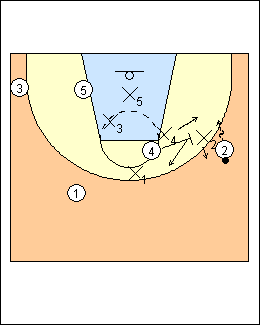 | Ice (Force Down) Brad Stevens (Celtics Ballscreens) - against a great player, ice to blitz, stay until the ball is passed. Switch if X2 gets beat (he calls it), or if 4 is a great shooter. Matt Woodley - if 4 pops and is a shooter, nail player X1 stunts at him on a pass, buying time for X4 to close out. Money (switch) in ice - X2 drives down 2, gets inside position on 4. Dave Smart - they weak everything on the other side of the floor (force left, ice). Mike Fratello - ice - the screener will dive or step back for a jump shot. Tom Izzo - turn down (black) - 4 can't shoot, X2 doesn't let 2 get to the screen, X4 (a shot-blocker) drops down. coachesclipboard.ca - the screener is not a perimeter threat and the defence wants to keep the ballhandler out of the middle. X2 quickly gets above the screen so 2 can't use the screen to drive middle, X4 drops off the screener towards the baseline to help prevent penetration. If 4 rolls to the basket, X4 will get help from weakside defenders. Teams may also choose to trap 2 with X2 and X4. Avery Johnson - sidescreen and close-out defence should be consistent. If the close-out is high-side, forcing baseline, then force the pick and roll baseline, trap, and rotate to leave the furthest attacker open (X1 takes 4). If the close-out is low, forcing middle, send the dribbler towards the screener but trap early before the screen is set. Van Gundy - "down" the ballscreen when there is an attacker in the ballside corner. A good attacking team will counter by using a step-up screen, so the dribbler can use it and go baseline. Mike MacKay - teams that use a sidescreen run a shooter to the corner, making it difficult to defend with rotating help defence, so don't allow the offence to use the screen. X2 gets into an extreme force position not allowing 2 to dribble to the middle, X4 sags to help on the baseline drive. A common counter is to re-screen, and step the screener out for a pass. The screener then passes and follows to ballscreen, xscreener must recover quickly to help. Jansen (coaching.fibaeurope.com) - use fanning when the screener can't shoot or with a great shot blocker. Switch or trap, the closest high perimeter defender (here X1) rotates to cover the escape pass to the screener at the high post. The offensive counter to fanning is a step-up ballscreen on the baseline side. Woodley - on a step-up screen, X2 goes under 3 out of 4 times, and spins under if he gets hit by the screen. Kevin O'Neill - blitz a step-up ballscreen until a pass, use the sideline and baseline to trap. Ettore Messina - if 5 sets a step-up screen, X5 protects the paint; if 4 (a shooter) sets the screen, X4 switches with X2 (who goes over the screen). If X4 zones up, there is no way he can recover on a pick and pop. |

